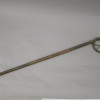Relatives/Heritage items
Displaying 261 - 280 of 4694 Relatives
Browsing allows you to see all the records for relatives and heritage items in the GKS. You can also search by material made, and/or filter by nations. To search by material made, type the material's name, by example 'leather', in the box below and click “Apply.” You can select multiple nations from the dropdown list by pressing “Ctrl” (on PC) or “Command” (on Mac) and clicking, then select “Apply.”
Small basket, made using plaiting technique, oval shaped
Oblong tray made of birch bark
A birchbark box decorated with porcupine quillwork and cedar root. There is a flyer inside, written by Chief Chas. Pokagon, dated May 21 1900, describing birchbark quillwork.
canoe model with figurine, birch bark with quill work, 1847 - 1853, Anishinaabe, made by Mary Kooyik (Mani Kueyik).
An Ojibwe wooden painted lacrosse stick, with a leather net. Part of the Pearsall collection, acquired in December, 1963.
Frame basket, rocking bottom, undecorated, with handle
This Anishinaabe mkak (box) is made from birchbark with a floral design made from quillwork. It was collected by Amos H. Gottschall between 1871 and 1905. His collection was likely left to the Academy of Natural Sciences of Philadelphia (ANS) sometime before 1937. ANS formally
This Anishinaabe mkak (box) is made from birchbark with a floral design made from quillwork. It was collected by Amos H. Gottschall between 1871 and 1905. His collection was likely left to the Academy of Natural Sciences of Philadelphia (ANS) sometime before 1937. ANS formally
This Anishinaabe mkak (box) is made from birchbark with a floral design made from quillwork. It was collected by Amos H. Gottschall between 1871 and 1905. His collection was likely left to the Academy of Natural Sciences of Philadelphia (ANS) sometime before 1937. ANS formally
A small black ash and sweetgrass basket.
An 18th century ceremonial dance wand with an incised horn or antler upper component and quill wrapped handle. Probably attributable to the Anishinaabe on the basis of the incised and quill-wrapped motifs. Formerly in the Leverian Museum in London where it was depicted in a
 Knowledge Sharing Platform
Knowledge Sharing Platform














